Andrew Collins's Blog, page 14
May 14, 2014
H.R. Giger changed my life

I was sad to read of the death, aged 74, of the Swiss surrealist artist Hans Rudolf “H.R.” Giger. Through his groundbreaking, influential designs for the alien and its environments in Ridley Scott’s groundbreaking, influential murder mystery in space Alien – a style that was known as “biomechanical”, a precisely airbrushed cross between the visceral and the metallic – he had more than crossed my radar. Although I was under the age of consent to see Alien on release in 1979, as an avid teen film fan I bridged the gap by requesting The Book Of Alien – a lavishly illustrated making-of by Paul Scanlon and Michael Gross – for my birthday in March 1980. Via the portal of this otherwise conventional softback souvenir, I entered the rarefied, graphic world of Giger (the book was full of initial sketches and designs by various artists, but his dominated).
This book, though cherished, did not change my life. But Giger did, in 1987, although I didn’t even know it at the time. I was a student at Chelsea School of Art in 1987, on the cusp of graduation and what I hoped would be some approximation of a “career” as an illustrator or more specifically a cartoonist (my chosen area of expertise in the sense that it chose me: I wasn’t much good at proper drawing). I had been an avid reader of the NME since the year Alien was released, and had keenly rolled with its evolutionary punches as it morphed from the inky rag of the post-punk era to a post-modern media studies pamphlet designed with acres of white space in the early-to-mid 80s. What I didn’t know, as a reader, in 1987, is that the paper was on its knees, commercially speaking. This would have been no concern of mine; as long as my weekly fix of music news, culture and dangerous Marxist politics arrived on a Tuesday, all was well.
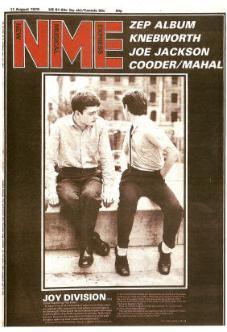
I was the sort of nerdy NME reader who pored obsessively over what I didn’t know at the time was called “the masthead” (ie. the list of staff and freelance writers), and noted any personnel changes with interest. As a student of art and design, I also mapped the visual changes in the NME in relation to whoever was designing it, and knew that the reigning art editor in 1987, Joe Ewart, had ushered in a starkly dynamic page layout, of which I approved. It was very much in keeping with advances in style magazine design over at The Face and i-D, except printed on shitty newspaper.
In 1988, I was living in a studio flat in South West London and attempting to keep the wolf from the door by taking on soulless freelance illustration work for a modest design agency. It was not “art”, but if I drew enough cartoon cats, cyclists and reindeers in a month for corporate handouts, I could pay the rent. (If you bought the puzzle magazine Puzzled around this time, you will have seen my cartoon owls, polar bears, penguins and other assorted fauna – this was the vertiginous level at which I toiled.) In order to satisfy my creative juices, I decided to produce my own fanzine and write about things that interested me and perhaps sell a few copies, like two new NME writers on the masthead whom I had quickly grown to idolise, Steven Wells (who produced Molotov Comics) and James Brown (Attack On Bzag).
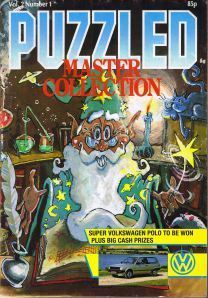
I did not make my own fanzine, This Is This, in their image; instead, I went for neatly typed columns of copy with – yes – plenty of white space around them. I wrote about Tony Hancock, Stephen King, Gerry Sadowitz and the water metaphors in Lloyd Cole’s lyrics, and drew my own cartoon strips satirising TV-AM, Time Out and Apocalypse Now. I borrowed the photocopier at the design company that employed me and used it to “size up” my illustrations and create a clean page design. Then I paid Kall-Kwik to print me up and staple 100 copies. My aim was to carry them around in an Our Price plastic bag and sell them at gigs. I think I sold around a dozen.
However – and here’s where my life intersects with H.R. Giger’s, without his or my knowledge – I sent a copy of This Is This to James Brown, recently installed Features Editor at the NME, and, I hoped, a kindred spirit. The height of my ambition at this stage was to have my fanzine mentioned in the bitty news section Thrills, which James edited. Maybe I would flog a few copies by mail order. What I wasn’t doing at this point was looking for a job at the NME. The prospect was a fictional one.

I’m glad that I didn’t know then what I know now about how the office of a weekly music paper works. Otherwise, I wouldn’t have wasted a stamp. The probability that the brown envelope containing This Is This would have been opened, never mind the contents being read, was close to zero. I could never have imagined how high the teetering pile of envelopes on James Brown’s in-tray was. However, the stars were aligned for me, and he did open my envelope, and he did flick through my fanzine, and he did phone me up.
In the message he left on my answer machine he said he liked the fanzine and wanted to have a chat with me about it. I was cock a hoop, and yet still only dreaming of seeing my fanzine mentioned in the pages of the NME. He invited me up to the offices of the paper in London’s New Oxford Street – which was, for me, like visiting Mecca – and casually mentioned that he might be able to put a bit of writing work my way.
Now, the history books tell us that back the white heat of July 1976, the NME ran a small ad asking for “hip young gunslingers” to write “lively and incisive prose” in an effort to refresh the lifeblood of the paper in the wake of punk rock with a new staff writer. (Actually, the history book – Pat Long’s closest-to-definitive The History Of The NME.) It ended up with two from the 1,200 applications: Julie Burchill and Tony Parsons, with Ian Cranna, Paul Morley and Paul DuNoyer taken on as freelancers. No such formal clarion call went out in 1988, but Brown and his successor on the live desk, Helen Mead, were unofficially tasked with trying out some new writers. It was in this spirit of provincial empowerment that I found myself sucked into the wonderful and frightening world of the NME. (Barbara Ellen, Stuart Maconie and Steve Lamacq were among those who also had their professional lives changed in the same period of conscription.)
Though lured into the office with the promise of writing work, a part-time vacancy was going in the NME art room and, technically if not practically qualified, I was introduced by James to editor Alan Lewis and new art editor (previously Joe Ewart’s assistant) Justin Langlands, who seemed to like me – or perhaps just my dungarees and Age Of Chance baseball cap – and took me on. All of sudden, from a standing start, I had landed a two-days-a-week post at my bible, which quickly expanded to three days. When Justin took his first holiday in the August of ’88, I actually became Art Editor for a fortnight; that’s two issues of the paper I’d read and re-read for almost a decade under my aesthetic control (yes, I redesigned all the logos while Justin was away, and Justin reinstated the old ones when he got back).

From my new vantage point, I set about bothering all the section editors for writing work, and one by one, they caved. My “journey” from layout boy to actual bylined NME writer had begun. The rest is autobiography. But without H.R. Giger, the man whose art had so captivated me in The Book Of Alien, my life might never have wound its rudderless way in this direction, and the NME might have remained a weekly newspaper I pored over and not one I actually tinkered with from the inside. The “media”, as I did not yet refer to it in 1988 – and an industry of which I did not count myself as a member – might have remained over there. I have no idea if I would still be a freelance illustrator, providing print-ready artwork for puzzle books, but it’s conceivable. If not for nine erect penises …
In 1987, when my wildest dreams still revolved around perhaps drawing my own comic strip for a newspaper, the NME I loved was undergoing one of its habitual regime changes. I couldn’t have known how seismic. According to Pat Long’s account, sales had fallen below 100,000 copies for the first time in 31 years. It is sad to say, but choosing Neil Kinnock as its cover star in the week of the General Election – a decision that thrilled me to marrow of my bones as a reader, and cemented all my political ideals – was symbolic of the NME‘s propensity to back a loser. The paper’s owners, IPC, saw that famous cover (“Lovely, lovely, lovely!”) as the shortest suicide note in history. Editor Ian Pye was sacked, and “safe pair of hands” Alan Lewis was parachuted in.
His commercial instinct and desire to drag the NME back to being about – hey – music were seen as anathema to remaining stalwarts like media editor Stuart Cosgrove PhD – a mid-80s appointee of editor Neil Spencer, under whose leadership the paper entered what was, for me, a purple patch of polemic and pretense. It was future Channel 4 Controller of Arts and Entertainment Cosgrove who produced an issue devoted to censorship while Lewis was on holiday in September ’87, which involved the reproduction of a sexually explicit painting by H.R. Giger known as Penis Landscape. It had been given away as a poster by Californian punk activists the Dead Kennedys in 1985 with their Frankenchrist album and landed the band and their lable in legal hot water. It depicted nine erect penises entering nine orifices that could be vaginas or anuses. What could possibly go wrong?
The NME folklore passed down to us was that the printers had refused to print it and downed tools. According to Long, it was more a case of the colour repro lab complaining about having to print it, but the industrial kerfuffle gave IPC management the excuse to get rid of the staffers it considered “troublemakers”, notably Cosgrove – who I presume considered it a cause worth dying for – and Joe Ewart. “Media” returned to being a token section of the paper with film and book reviews in it, and Ewart’s assistant, Justin, took the art reins. (Having worked under him, I know that Justin was surprised and delighted to get the gig, although the trade-off was allowing Alan into the design room, whose lack of design finesse did not stop him wielding a scalpel and demanding bigger, clearer, more literal layout.)
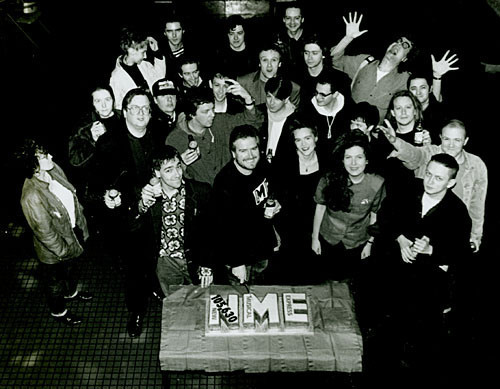
Without understanding its significance, with a few months of my arrival in Justin’s art room, the NME moved offices back to IPC’s skyscraping HQ King’s Reach Tower in Waterloo. We were the unruly child, taken in hand and put under the same roof as Mum and Dad. I had no real idea that I was part of a new era, but events have proven that to be the case. Under Alan’s earnestly commercial helm, we started to produce a tighter, brighter, more focused, less discursive and more humorous paper. The circulation went back up. We even managed to cover Acid House within the newly revived, conventional rock format, made easier when, during the Madchester boom, guitar bands took E and picked up samplers, while Lamacq and new lieutenant Simon Williams plugged directly into an energised, corporate-sponsored indie scene. (As Lamacq told Long, “Everyone at that time wanted Danny Kelly’s approval,” and this genuflection to the larger-than-life successor to Alan Lewis generated real heat in the office, regardless of musical affiliation.)
If you’d asked me my preference as a media outsider in 1987, I would have wished for a Labour government and the continuation of the Ewart/Pye/Cosgrove regime. I would have cheered a pullout H.R. Giger anal fantasia every week and stuff those evangelistic reactionaries in the print trade. But it was not to be. There’s only so much sticking it to The Man you can get away with when you’re part of the machine, which the NME always was. (Believe it or not, we never referred to it as a “brand” in the late 80s – that was all to come.)
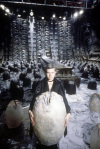
So rest in peace, H.R. Giger. You changed my landscape, and very possibly paved the way for Hull indie rockers Kingmaker to breach the Top 20 in 1992.


May 7, 2014
Run and run
Two big new cop shows this week on Telly Addict: Prey on ITV by first-time writer Chris Lunt (way to start an IMDb entry!); and Happy Valley on BBC1 by veteran Sally Wainwright, which surprised me; also, the German miniseries Generation War on BBC2; the exceptional and frank documentary from Rupert Everett, Love For Sale, on C4; and sketch show Cardinal Burns on C4. Oh, and a bit of Gogglebox Zen.


April 29, 2014
Here is the mumblemumblemumble
Two talking point TV shows on Telly Addict this week: BBC1′s top-notch Jamaica Inn, which found itself embroiled in a teacup-storm about the mumbling of tightly-wound character actor Sean Harris, whose performance as the dastardly Cornish innkeeper Josh Merlin was typical for him and catnip to his fans, but not helped in this instance by a “technical” issue that muddied the sound of the live broadcast of Easter Monday’s first episode. Cue: self-flaggelation by the Corporation on the News and elsewhere. (I watched it on catch-up, which suffered no such issue, so enjoyed the whole thing thoroughly – then again, I like straining to find the rhythm of a performance, if it’s well done – anyone who watched all of The Wire will understand how bracing it can be.) Also, there was the much-chattered-about Derek on C4, whose titular performance took flak when it first emerged, and to be honest, little has changed. Also, less controversially, unless you believe Bible stories to be sacred (so to speak), the Easter episode of the finite Rev on BBC2; and Boss on More4, which returned in confident style, even though its fate is sealed. And a bit of Mad Men that’s not a spoiler. That’s the kind of controversy I like to avoid.


April 28, 2014
Writer’s blog, Weeks 16-17, Monday
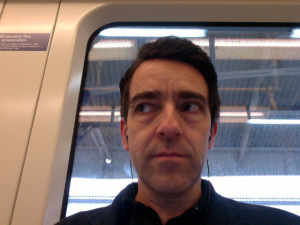
Welcome to my world. My name is Andrew Collins. You may know me from my recently updated mug* on the film pages of the Radio Times, where I give three stars to two-star movies, or four stars to three-star movies just to annoy you. Or from my moving face in an oblong that magically appears every Tuesday morning or thereabouts on the Guardian website, so that at least one commenter a week can bemoan the fact that it’s a video and not a written review of the week’s TV, which is a bit like complaining that a cat is a dog. Although visible, both jobs involve writing. But what I’m doing most of the time, you can’t see. It’s me, at this laptop, stringing sentences together in the fervent hope that they will one day come out of the mouth of a professional actor.
*

In order to stay sane, I also write that other blog, Circles Of Life: The 143 Best Songs In The World, which gives me an enormous sense of wellbeing, as I don’t have to show it to anyone in order for it to be published, as I publish it myself. Nor do I have to wait until someone asks me to write a short, personal essay about, say, Across 110th Street or Venus In Furs. I simply ask myself, and then do it. If there’s time. Incidentally, I was rather pleased that Scotts menswear (who make wear for men) have chosen to republish a number of my 143 blog entries on a special website celebrating the life of men over the 30 years they’ve been making clothes for them. (The site has been edited and designed by Sabotage Times and looks terrifically smart.)
There hasn’t been much time in 2014. As you’ll have picked up from previous Writer’s Blogs – few and far between of late – I’m hard at it.
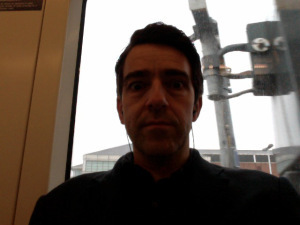
The above PhotoBooth photos were taken on the same overground train journey on Friday. They are not very interesting, but where I was going is. What I think I might once have referred cagily to as Sitcom A is now released from the captivity of superstitious secrecy, even while it remains below the line “in development”. It has been revealed – via the on-the-ball British Comedy Guide – as Wild Life, a single-camera comedy about a five-person nature documentary film crew on location. I’ve been developing it – which means writing and rewriting and rewriting it for a fixed amount of money which stays the same however much work I do – for two years at my management company, Avalon. But here’s where it gets interesting.
On Friday afternoon at 2pm, we staged the script for a small audience of invited TV bigwigs and comedy fans without nine-to-five jobs. This is habitually done in the world of comedy (we did it for Grass, way back in 2002, and landed a commission wit it), but usually in an airless conference room. We did Wild Life, scripts in hand, in a small theatre-above-a-pub in West London called the Tabard. A terrific venue, the cast rocked up at 10.30, and within a few hours were “performing” the script, live. It’s like a huge audition, for me as the writer**, for them*** as the cast, and for Avalon as the prospective production company. And it lasts half an hour, and then it’s done. I’d say we gave it our very best shot. It’s in the lap of the gods now.
** Although I wrote the script, we drafted in my old sparring partner Simon Day to help make it “funnier”, to use arcane industry jargon. It was a huge amount of fun being locked in an office with Simon again. And he did make it funnier.
*** Although Simon was away and couldn’t cameo on the read-through, as he would have wished, the cast assembled by Avalon was supreme: Frankie Boyle****, Miles Jupp, Isy Suttie, Craig Cambell, Adam Hess and Angela Simpson.
**** Frankie took to Twitter to “correct” the British Comedy Guide’s article. But don’t believe the hype, he is as nice as Noam Chomsky-reading pie in real life and I would love it if you could see him in Wild Life in a utopian future where my scripts get made.
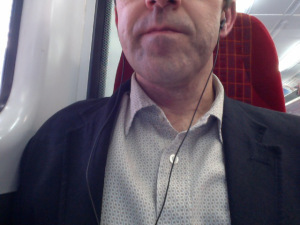
Meanwhile, what I’ll stick to calling Sitcom B, which I’ve been co-writing with the comedian who will star in it (a pattern that follows Grass and Not Going Out, an arrangement to which I appear to be suited), has hit its third draft, which is frankly unrecognisable from drafts one and two, and this is a good thing. This has been approved by our bosses at Avalon and has been delivered to the broadcaster, which is the BBC. Balls are up in the air again.
The above award-winning photo is me on my way home on the train from the Guardian on a humid Monday afternoon, hence the shirt. The big story in my professional writing life remains Drama A, another 50/50 co-write, which has just been rewritten for reappraisal by the broadcaster who has put it in development. What I will say is this: it’s weird – and a relief – not having to put jokes in.
Back to work, then. Telly Addict number #151 will appear miraculously here tomorrow morning at around 10am. In that shirt.


April 15, 2014
So true, funny how it seems
The season finale of HBO’s True Detective on Sky Atlantic towered imposingly over my telly-watching week; however, those in self-imposed exile who don’t have Sky won’t have seen this initially mind-blowing and even towards the more conventional ending superbly acted Southern Gothic whodunit, so Telly Addict does its usual dance around potential spoilers; we’re on safer ground with Gogglebox on C4; The Battle For Britain’s Breakfast and estate agents docusoap Under Offer on BBC2; plus the start of season five of Community on the Sony channel (is it too late for me?) and the end of the glorious season three of Parks & Rec on BBC4. You have, once again, been watching.


April 9, 2014
Get GoT
This week’s Telly Addict does not feature the first episode of the new season of Game Of Thrones, which, after weeks of hype, went out on Sky Atlantic at 2am on Monday morning (or Sunday night, if you prefer), to sync with the US premiere on HBO. It’s impossible for me to review this epic saga without spoiling it for those without a Sky subscription, an HBO subscription or the spirit of lawlessness to illegally download. So, as an experiment, and a one-time-only deal, I have reviewed it separately, here. Thus, the regular Telly Addict is here. It’s all about New Worlds on C4; Klondike on Discovery; The Trip to Italy on BBC2; Monkey Planet on BBC!; Endeavour on ITV; and a bit of The Voice on Gogglebox on C4.


April 1, 2014
More TV, Vicar?
A piece of Telly Addict that will be forever England this week, from the thoroughly English (certainly Anglican) Rev on BBC2; the thoroughly American-English Martin Amis’ England on BBC4; the thoroughly British, although surprisingly European A Very British Renaissance with the fantastic Dr James Fox on BBC2 (promoted, one might say, from BBC4); the thoroughly English Louis Theroux, who’s moved to LA and made LA Stories for … BBC2; and, not at all English, but still British, and with English subtitled, 35 Diwrnod, the latest in Welsh-language noir from S4C, which is available, subtitled, on their website, if you can’t access it via Sky or other satellites.


March 25, 2014
Licence fee saved
I’m looking back on this week’s Telly Addict to what might be regarded as “quite a night” for BBC2: Wednesday, when Line Of Duty reached its much-talked-about and much-watched conclusion after six weeks of internally investigative cop intrigue, and was directly followed by a brand new comedy, W1A, specifically pitched and designed to take the royal piss out of the BBC. This, you might argue, is what the BBC does best. Also: The Widower, Jeff Pope’s latest true-life murder tale on ITV, where he works; Undercover Doctor – Cure Me I’m Gay with Dr Christian Jessen playing the gay Louis Theoux on C4; and two 30th anniversary specials, Arena: Whatever Happened To Spitting Image? on BBC2 and The Miners’ Strike And Me on ITV.


March 18, 2014
London sucks
Sorry, failed to announce last week’s Telly Addict (and the one before) on this blog, due to crashing deadlines, so here, in the traditional manner, is the alert for what is, in code, TA145, that’s the 145th weekly TV review I’ve done since April 2011. Coming up to its third birthday! And still basically dancing the same jig: what I have done watched on the telly during the week previous, discussed, with myself, in a manner than cannot meaningfully be transcribed and run as text on the Guardian website, despite constant, whining calls for this service. (The same folk must often complain to a dog that they’d rather it was a cat.) Here we go then: Mind The Gap on BBC2, a nuanced look at the way London sucks talent and money away from “the rest of the country” from Evan Davis; Gogglebox, of course, on C4, although rationed doses for this third series, as as not to do myself out of a job; Shetland on BBC1, a detective drama almost as bleak as Hinterland; the delightful Great Canal Journeys with Prunella Scales and Timothy West on More4; the misleadingly titled Michael McIntyre Chat Show on BBC1; and a clip from Astronauts: Living In Space on C4. Normal service resumed.


March 17, 2014
Cock and ball stories

“Contains strong, real sex.” There’s a warning which, for some, will operate as an enticement. It adorns the posters for Stranger By The Lake (or, more properly, L’Inconnu du lac) a current French erotic thriller that’s been picking up five-star reviews and which I went to see for my birthday. It was quite a present.
The story – one of social intrigue, moral ambiguity and brazen man-on-man rumpo – revolves around a secluded, idyllic gay cruising spot in the South of France on the edge of a man-made lake, where man-made men of all ages routinely spend the day sunbathing, swimming and chatting, often nude, as a springboard to sexual acts in the undergrowth. Notwithstanding the thriller element, it paints a utopian picture (all the better to be shattered by the thriller element). The sun glistens off the water. Blue skies gradually fade to cool evenings. There is ample car parking. Nobody seems to have a job to go to. Consenting adults get to know each other on towels, or not, and partner off, while others simply loiter in the bushes and watch.
For a lifelong heterosexual who was ostracised as a “poof” in his teens for dressing effeminately and warned off hanging out with actual gay men by his parents as it was interfering with his A-levels, onscreen portrayals of this sort of “scene” – ritualistic, understood, honest, practical – always fascinate me, I cannot lie. All the bullshit that goes with heterosexual courtship is refreshingly absent. Although most of the men in the film are fit, buff and handsome, some are older, fatter, and less idealised looking. Some are single, some are not. Most use condoms, others play a riskier game. It’s the perfect milieu into which to introduce a less controllable danger: that of murder.
Outside of the thriller aspect, which recalls some of the more generic tropes of Plein Soleil and its English remake The Talented Mr Ripley, with more literal recent echoes of Jane Campion’s Top Of The Lake, and even The Returned, Stranger By The Lake is notable chiefly for being the latest 18-certificate film to blur the borders between simulated sex and real sex – that is, frank, explicit, non-simulated, and thus by most people’s definition “pornographic”. The sex we’re used to seeing onscreen, even in “sexy” films, is clearly all artful, choreographed bump and grind, and elevated to gentle titillation by soft focus, tantalising editing, orgasm acting and a saxophone. The sex herein involves erect penises and ejaculation. There, I’ve said it.

The screening of Stranger By The Lake we attended was in Soho and on a weekday morning. I specify “we”, as all other patrons in the cinema were singles, and male, and – dare I generalise? – of a certain age. Not young men. This was an 18-certificate showing of a film. Not a porn movie in a porn cinema (although I’m sure Old Testament Daily Mail moralists would have a thing to say about its content). And yet, as specified, it contained images of strong, real sex. Which you don’t get on the telly, not even in the background on True Detective.
As unfashionable as it may be to say it, I’m not partial to porn. I actually get more out of one of those faked, edited, saxophone scenes in 18-certificate movies, albeit briefly. I have no great desire to see people “do it” for real. But many do and they are better served in this regard than ever before. So is it wrong to pay money to see Stranger By The Lake for reasons on titillation? No. This is a healthy desire, albeit one perhaps better served at home. Because a lot of the film comprises people sitting on towels and talking, often about very little of import. If it were porn, it would be quite annoying.
As a film, I think it’s quite brilliant. Singular, atmospheric, cool, disturbing; elliptical and sometimes unclear in terms of what’s going on, but of a piece with the naturalistic way it’s shot and acted. Director Alain Guiraudie holds his nerve, and the recurring fixed shot of the car park is a brilliant, evocative way of showing the passage of days. Pierre de Ladoncahmps and Christophe Paou are captivating as the younger, more innocent, smooth-skinned tourist Franck and the older, more hirsute alpha male Michel, respectively. It is their relationship – essentially sexual, but with emotional benefits – that drives the story. And although you think you see them have “strong, real sex”, the more real bits are performed by body doubles. Even actors who are prepared to go full frontal are not necessarily up for going all the way.

A similar sleight of hand, or slight of genital, occurs in Lars Von Trier’s Nymphomaniac Vol I and II, a diptych that really impressed me when I saw a preview of it in January – both films back to back, a four-hour sex marathon – and which I would recommend if you’ve enjoyed his previous work (particularly the first and second parts of this, Von Trier’s loose “trilogy of depression”, Antichrist and Melancholia). It’s surprisingly linear, telling the self-loathing life story in flashback of the fearless Charlotte Gainsbourg’s sex addict. Each “chapter”, adorned with symbolism and cod-Freudian analysis, touches on a different aspect of her sex life, from virginity-shedding to sado-masochism and beyond, and there’s a good deal of what looks like “strong, real sex”.
And guess what? It’s not Shia LaBeouf or Charlotte Gainsbourg’s parts you’re seeing going into each other, or being spanked or sucked. It’s the parts of some porn actors, which have been seamlessly edited or digitally composited into the action. (See also: the astonishing Blue Is The Warmest Colour, which also apparently involved full prosthetic vaginas that the non-porn actors were strapped into. It’s amazing what they can do these days.) Although some of the sex – particulary between LaBeouf and Stacy Martin playing the young Gainsbourg – borders on conventional, if not quite Hollywood, and its pretty torrid, but I would still steer you away from Nymphomaniac if it’s titilation you seek! Much is seedy and disturbing, not least the scene where two African men have an argument over Gainsbourg while standing there naked and erect, like swordsmen. (That is, disturbing in the men’s attitude to Gainsbourg – which, to be fair, the character has masochistically brought upon herself – but also quite a sight if you’re not used to seeing men with erections banging around in front of them.)

Coincidentally, Pierre de Ladoncahmps from Stranger By The Lake, the non-hairy one, reminded me of Patrick, the lead gay man in Looking, HBO’s simply adorable new comedy-drama about life on the non-heterosexual side of San Francisco, just coming to the end of its first season on Sky Atlantic. More education into the way things work within the gay community in America’s gayest city. (I loved San Francisco the moment I set foot in the place back in the early 90s and fancied myself as quite local on a two-week stay there.) Patrick, played with puppy dog charm by Jonathan Groff (whom I don’t even remember from Glee), is far less aggressively gay than his two companions, the experimental Agustín and the seasoned Dom, in that he’s yet to be seen in a bathhouse and only in leather as fancy dress, and I guess he acts as a “way in” for hetero viewers. But the show does not shrink from its sexual preference. It could be about any firm friends in any city and their lives and loves, but many of the “issues” are gay-specific. I love it.
I think I was bound to; one of its founding writers and directors is Andrew Haigh, the openly gay British filmmaker whose second film Weekend I only belatedly caught on Film4 this year. It’s as fetching and raw and irresistible as the reviews said at the time of its release: simply, the whirlwind 48-hour romance of two men in Nottingham, whose relationship is concertinaed by the fact that one of them is leaving for America on Monday. (Just as the talented Haigh would, ironically.) It’s nothing like as sexually explicit as Stranger By The Lake, but it’s still frank and unabashed, and once again depicts the mechanics of “encounter” culture – what the cool kids in America have now dubbed a “hook-up”, I do believe: sex without strings, something women are now permitted to admit to pursuing. (Imagine!) This bypass of traditional courtship is again refreshing and confusing to a Victorian gentleman like myself.
Although it is simply beyond my understanding how anyone could regard a same-sex relationship as any less valid or meaningful or natural as a bi-gender one – I mean, really, are we still debating same-sex marriage and the equalisation of rights in the 21st century? – I do seem to have been exposed to a lot more gay cinema and TV of late, and my reaction to it is bound to be different to the reaction of someone gay, lesbian or transgender. Heterosexuals: we’re like the fourth emergency service!
Dallas Buyers Club is an Oscar-stamped film about the gay community, set at a time when it was under attack not just from Bible-bashing moralists and the ignorant but from a new virus, too. Matthew McConaughey’s real-life Texan protagonist is super-straight and in his bones homophobic, and his shifting attitude to the likes of Jared Leto’s male-to-female transgender, HIV-positive drug addict forms the heart of the story. It is essentially a heterosexual film about homosexuality, and, like Patrick’s “soft” gay man in Looking, McConaughey’s conflicted cowboy acts as a bridge into another world.

I grew up in the 70s, when gays were figures of fun in entertainment, and little more. Thankfully, come the 80s, when my politics started to harden, gay storylines became de rigueur in soaps and entered the mainstream. The terror of AIDS served to either confirm or wash away prejudice. The tabloids continued to treat homosexuality as something that must be “confessed” by celebrities right through this progressive decade, and homophobia is still horribly rife among certain knots of men. But much progress has been made. The Sun still objectifies women and reduces anything complex to single syllables and capital letters, but you don’t sense that the simple act of being gay is the news story it once might have been.
All that said, I wonder if some of the five-star reviews from heterosexual critics for Stranger By The Lake – mine included – are borne out of solidarity as much as out of dispassionate critical consensus. A willfully contrary, negative review of Under The Skin at the weekend called it “misogynistic” for its male gaze upon the Hollywood body of Scarlett Johansson, and yet – without giving too much away – it’s the men who are presented as victims, not to mention meat, in the film. They appear completely naked, while she generally gets to keep her bra on, and are apparently priapic, although the light is low and my failing eyesight meant that I didn’t even spot that their members were erect! Maybe I’m just getting used to them?


Andrew Collins's Blog
- Andrew Collins's profile
- 8 followers










